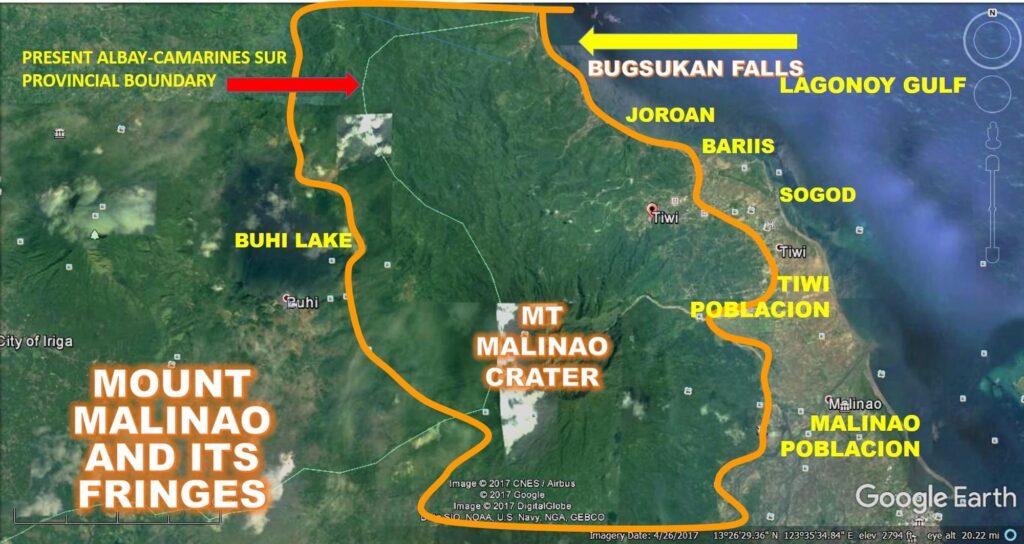By Abdon M. Balde Jr.
TO MOUNT MALINAO & THE FABLED CRYSTAL CAVE.
When I was infrequently visiting the town of Tiwi, I would meet friends who were culture enthusiasts such as Dan Pinto, Mario Limpo and Edgar Competente and on some drinking sessions they would mention the fabled crystal cave where the magical crystalline waters of the underground river flow—the very reason why the mountain was named Malinao (clear). The three are all dead now, but the stories they told remain alive in my memory.
During those days when I was searching for Ibalong in different places of Bikol, I was desperately looking for a place where Handiong and Oryol might have met amiably—where Handiong might have convinced Oryol to join his fight against the monsters. And where Oryol might have fallen in love with Handiong. It was then that I remember the tale about the fabled crystal cave. So whenever I was near Malinao I would ask around where there might be a cave in the mountain. I was told that it was the lair of the NPA rebels and that it would be dangerous to go up or near the mountain.
Mount Malinao is closer to Tiwi than to the poblacion of Malinao. One looking up the mountain these days would be wondering about the white smoke rising up its thick forests and vegetation. These are boreholes done by the Tiwi Geothermal Plants operating around the mountain—the first of its kind in the country. In 1964 to 1967 the Philippine Commission on Volcanology began exploring the possibility of building a geothermal plant on the fringes of Mount Malinao, near the town of Tiwi. Geological mapping and surveys as well as test drillings for underground temperatures were undertaken during that period.
In September 10, 1971, the Philippine Government thru its state-owned National Power Corporation (NPC) entered into a contract with Philippine Geothermal Inc. (PGI) to explore the geothermal resources of Mt. Malinao near Tiwi. The PGI was actually a foreign company clothed in a local business name. It was actually the Union Oil Company of California (Unocal), an American energy exploration company which had environmental desecration suits and corrupt practices cases in Burma (Myanmar) and other Asian countries. It was invited to come to the Philippines by the cronies of then President Ferdinand Marcos. NPC built and operated the Tiwi Geothermal Power Plants while PGI merely provided the technical expertise. The first power plant with a capacity of 275 MWe (megawatt electrical) became operational in 1979. Later, Tiwi Geothermal would be the first plant in the Philippines to generate over 160 MWe. The production field of Tiwi Geothermal covers about 13 square kilometres in 4 geographic areas: Naglagbong, Kapipihan, Matalibong and Bariis. Commercial production in the Naglagbong and Kapipihan started in 1979 with the commissioning of the first 110 MWe power plant (Units 1 and 2). The big producers then were the Matalibong and Kapipihan sectors. Units 3 to 6, each 55 MWe began generating electricity in January, 1980, March 1980, December 1981, and March 1982, respectively. Nearly 200 wells have been drilled throughout the field. The deepest well has a measured depth of 2784 m (9130’) while the shallowest is 938 m (3078’). The irony of this is that electrical power is now purchased from the power plants in Laguna, while the power generated in Tiwi is being supplied to Metro Manila, thus the kilowatt price of electricity in Albay is the highest in the country at almost P19 per kilowatt. The people Albay will not miss the Tiwi Geothermal Plant if its operation will stop and the operators move out elsewhere. The Geothermal Plant has lost its appeal and usefulness to the local people. What would probably be missed were the small favors received by some local officials, if any. When calamities come, the people will remain in the dark, powerless and helpless—with or without the geothermal power plant.
Then in late 2005 thinking of visiting the Lagonoy Gulf, where according to Prof. Merito B. Espinas, Baltog sailed southwards we chanced upon a waterfalls in Barangay Misibis, Tiwi called Bugsukan. Its water coming from the slopes of Mount Malinao jumped directly to the seashore or to the waves of the Lagonoy Gulf. It used to be a tourist attraction in the early 1960s, however visitors were usually turned off by the steep and slippery stairs and the lack of area improvements and amenities for visitors who would like to enjoy the cascading waters.

We went down the over 100 steps to the seashore. I was with my wife Fe, Dan Pinto and Mario Limpo. Near the rocky shores where the water fell, were thick vegetations of coconut, talisay and bamboo grooves. I met a young man who told me that there used to be a cave near the waterfalls. Together we climbed up the craggy slopes of the mountain until we reach an area partly covered by the roots of an old tree. The young man said that his elders saw a cave there long ago. But now it’s covered with huge boulders eroded by earthquakes and floods from above.
Standing on the probable mouth of the cave I looked down the shoreline where the waves lap the rocky cliff. What I saw was the panoramic view of the Lagonoy Gulf up north where I could barely see the Atulayan Island and down south the Albay Gulf where the promontories of Tiwi and San Miguel Island were blurred by the glow of the rising sun.
At that moment I believed I have found the entrance to the crystal cave and the magical underground river of Mount Malinao. All that I need would be a clear imagination of the plausible meeting between the good and the evil.


